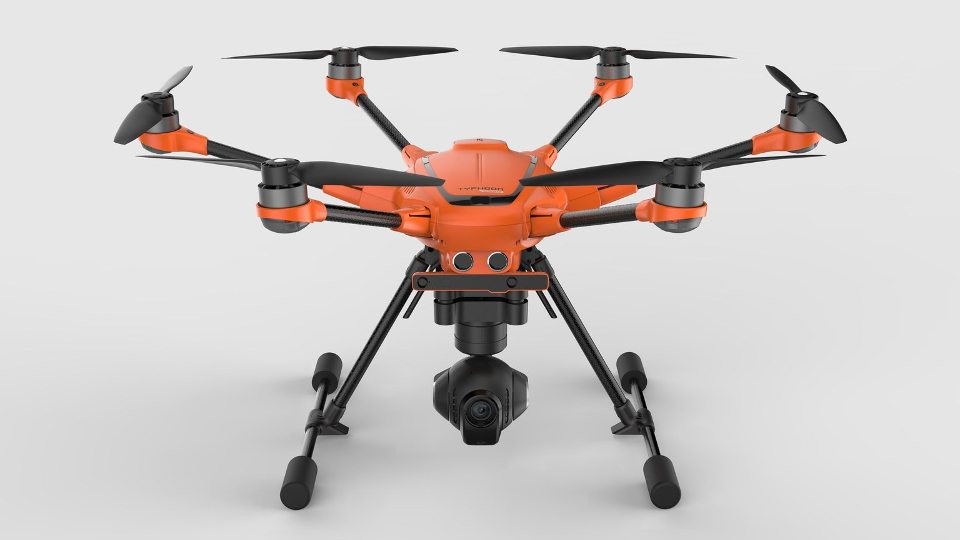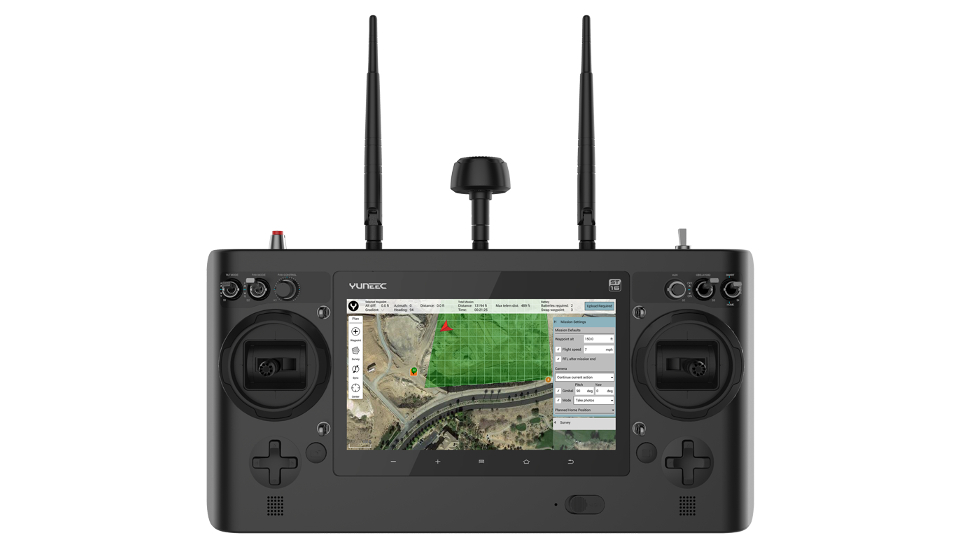Review: Yuneec H520 Drone & ST16 Controller
Drones are used in real estate, various industries, corporate and training videos, and even Hollywood has embraced the drone experience. Drone technology is here to stay — but how do you choose the right model for your specific needs?
Ranging from department store models to massive units capable of lifting heavy cameras, drone selection may be a daunting task. Drone manufacturer Yuneec makes the decision much easier with the introduction of the bright orange H520 hexacopter (i.e. six rotors); the E90 wide angle, and E50 40mm equivalent gimbal stabilized, 4K capable camera; and the ST16S controller.
Our university has two drones and our students and faculty are the only people allowed to use a drone on campus. Yuneec was kind enough to offer the H520 for us to shoot a period film utilizing 4K aerial footage that would intercut with material from our RED camera.
Features
With most other drones being white, the Yuneec H520 drone’s most distinctive feature is its bright orange color that allows the operator greater ease is distinguishing it from gray, overcast skies and drab buildings. The two sensors in the front prevent collisions with objects, and if one of the six motors should fail, the unit will still return home safely. Also included is DataPilot — software that allows auto-generated survey paths for 3D output on the controller. Three 4S 5250mAh lithium polymer batteries and charger are included. With a 25-minute flying time per battery, a voice output will tell you if a potential problem might occur or alert you if less than 30% remains on your battery.
Packaged in a durable Pelican case, preparation is as simple as extending the arms and attaching the six rotor blades (with four extras). Resting on retractable landing gear, the E50 camera (two thirds-inch CMOS sensor; 12MP; 40mm lens; UHD 4096 x 2160 and 3840 x 2160 at 24 or 30fps; or 1920 x 1080 at 24/30/48/60/120fps MP4 recording), or the E90 camera (one-inch CMOS sensor; 20MP; 23mm lens; 4K 4096 x 2160, UHD 3840 x 2160, and 2720 x 1530 at 24/30/48/60fps, FHD 1920 x 1080 and HD 1280 x 720 at 24/30/48/60/120fps, in MP4, H.264, H.265, and MOV) — either may be mounted with its attached 360-degree gimbal. Stills and video footage is captured on an internally mounted microSD card in the camera.

The Android-based, 5.8 GHz Wi-Fi-based ST16 controller ground station acts as a transmitter and receiver with up to a one-mile range that allows real-time viewing on its seven-inch 720p touchscreen with HDMI outputs and a hood.
The front of the ST16 controller features and on/off switch; left and right joystick controllers; still or video on/off functions; pan and tilt modes with rheostat speed control; obstacle avoidance on/off; manual/angle/home operation; landing gear up and down switch; as well as rotor stop and start button.
Lastly, although the Yuneec H520 is intended for commercial use, it also has many broadcast applications. Repeatability of shots is necessary when doing traffic reports from a drone. The controller allows for preplanning and recalling of shots to be repeated. The HDMI output allows 720p video steam may be sent to a broadcast truck, cell network or to a video village on location.
In Use
For a novice drone user like myself, Yuneec made it extremely easy to sync the controller with the H520. After both the controller and drone are powered up, pressing and holding the red button on the controller activates the rotors. The drone lifts off the ground, position the camera, and begin shooting.
We needed two types of shots for our fairy-tale script. The opening of the film required the Yuneec H520 to fly over our 575-acre campus — close to the ground to show the rolling hills and plains. The footage on the controller was steady and slightly difficult to see in the sun’s glare. Keeping my face close to the hooded screen helped.
A tip — I recommend having another person to act as a spotter because if the camera is turned anyway other than the direction the drone is traveling — you’re seeing the camera’s input and not watching where the drone is going. Even then, the split second my spotter shouted “A tree…,” the H520 was in the tree. The obstacle avoidance sensors can’t distinguish slender branches.

After walking the quarter mile to the location, I saw the orange battery on the ground, but no drone. Eighteen feet up in a tree, the Yuneec was tangled sideways. My helper climbed the tree and shook it and I waited with extended arms to catch the prize as it dropped. Talk about durability — no scratches, scuffs, nicks, dinks or missing rotors. It looked as perfect as it left the box. Hoping to watch the video of the impact, it appears that when the battery ejected, the video file disappeared also.
A second attempt gave us the perfect image. As the wind picked up slightly, we could see the drone moving side to side rather violently. However, even with the drone “jerking” back and forth, the camera footage was stable — a smooth Steadicam-worthy shot. The gimbal really works!
The second shot was a steady lift from the ground with the camera panning 360 degrees showing the five actresses in the scene. Spaced far enough apart so the rotors didn’t blow their hair, the shot looked amazing. We were not shooting under ideal conditions — in that the day was windy and a slight drizzle was falling.
[Read: FAA Recommends Best Ways to Identify Drones]
When moving the joystick controls too quickly, the Yuneec H520 can “jerk” as seen by the eye, but the gimbal dampened all but the most violent moves. The feature that I admire most is the “RTL” or Return to Landing command. Simply touching that button anytime in the mission and sliding the icon on the bottom of the screen returns the drone to the spot where the flight originated to within a few feet. This is extremely helpful when you’ve lost visual site of the drone and want it back.
Sadly, I am now “hooked” on drones — especially the Yuneec H520. Adding a flyover or a fly-along shot greatly enhances the look of any video. This technology opens up new creative ideas for the use of drones. I will never make a film again without a drone involved. I hope it’s always a Yuneec.
Summary
An amazing drone with the flexibility to shoot 4K video, stills, automated lift off, return to landing, and mapping. The gimbal mounted camera eliminates excessive drone movement by recording rock-solid images. Large, easy to see controller.
Applications:
When recorded, stabilized aerial footage is needed in a multitude of formats. The H520 takes some of the fear out of drone flying with its automated features.
Key Features:
Yuneec H520 — bright orange color, quiet operation, automated take-off and landing, obstacle avoidance sensors, 360 degree stabilized 4K capability, one mile range, four hundred foot ceiling, retractable landing gear, and collapsible arms and rotors for easy storage and transport. ST16S controller — large, easy to see seven-inch touchscreen, detailed flight information display, long battery life, and all controls conveniently located.
Price:
Yuneec H520 Hexacopter Drone, E50 and E90 cameras, three batteries, charger, ST16S controller, and Pelican case — $4,500.
Contact:
Yuneec USA
2275 Sampson Ave, Suite 200
Corona, Calif. 92879
Toll Free: 855-284-8888
Chuck Gloman is an associate professor and chair of the TV/Film Department at DeSales University in Center Valley, Pa. He may be reachedchuck.gloman@desales.edu.
Get the TV Tech Newsletter
The professional video industry's #1 source for news, trends and product and tech information. Sign up below.
Chuck Gloman is Associate Professor with the TV/Film Department at DeSales University.

